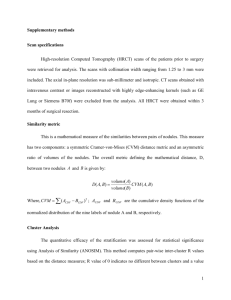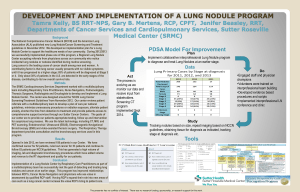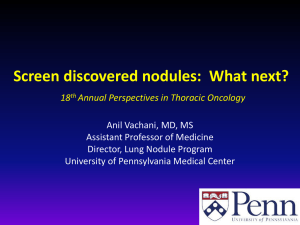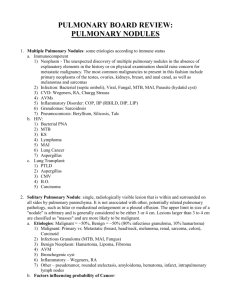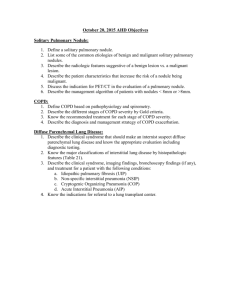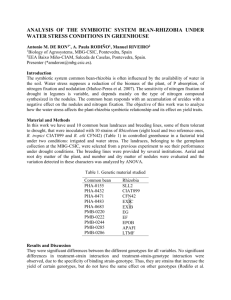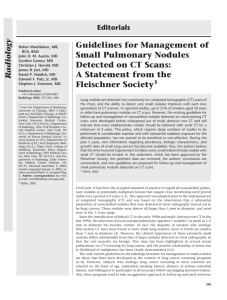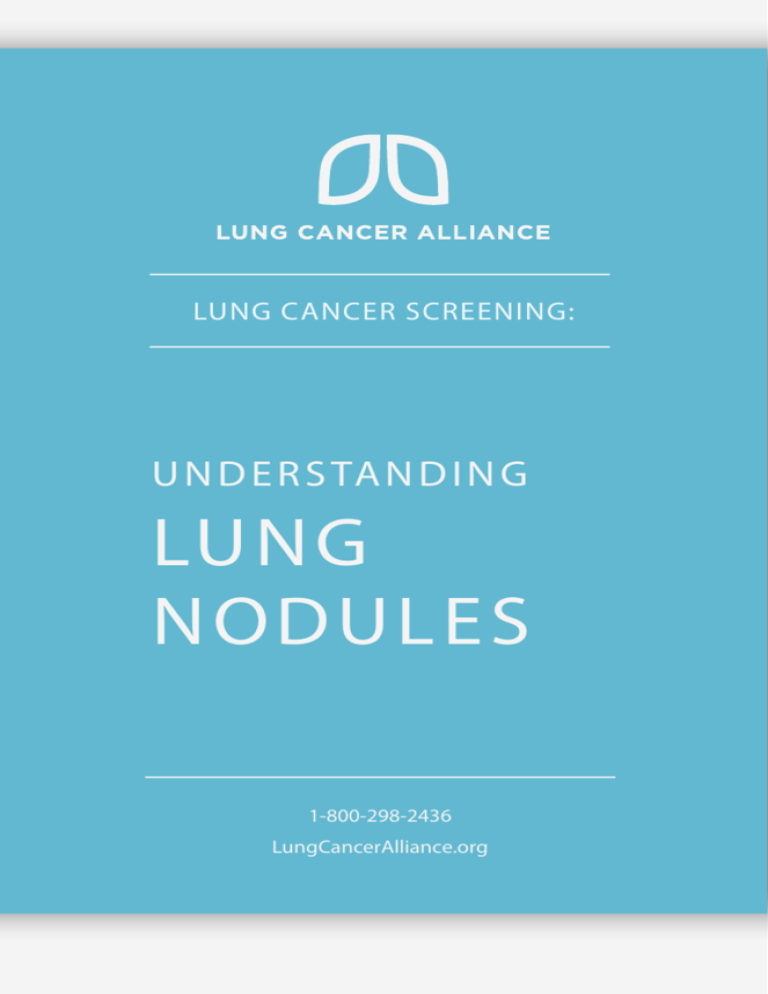
LUNG CANCER SCREENING:
U N D E R S TA N D I N G
LUNG
NODULES
1-800-298-2436
LungCancerAlliance.org
1
1
CONTENTS
What is a Nodule?..............................................................................................................3
Finding Nodules................................................................................................................4
If a Nodule Is Found..........................................................................................................5
What Happens Next?.......................................................................................................7
Questions to Ask about Your Results..........................................................................8
For More Information.......................................................................................................9
About Lung Cancer Alliance....................................................................................... 10
2
WHAT IS A NODULE?
CONGRATULATIONS ON TAKING THIS
IMPORTANT STEP AND MANAGING YOUR HEALTH BY
GETTING SCREENED FOR LUNG CANCER. THE FACT
IS, FOR MANY PEOPLE WHO ARE SCREENED, LUNG
CANCER WILL NOT BE FOUND. WHEN SOMETHING
IS FOUND, IN MOST CASES IT IS NOT CANCER. BUT
IF YOU ARE AT RISK, SCREENING IS THE BEST WAY
TO CATCH IT EARLY WHEN IT IS EASIER TO TREAT.
Lung nodules are abnormal spots that may show up on your lung cancer
screening scan. Doctors may call them lesions, coin lesions or solitary
pulmonary nodules (SPN). Lung nodules are very common – at least 50% of
people have them by the time they are 50 years old. The challenge is figuring
out which nodules are or will become cancer.
All lung cancer starts with a nodule but 95% of lung nodules are not cancer
and most do not need further attention, especially in people at low risk for
lung cancer. Nodules that are not cancer may be the result of a bacterial or
fungal infection in the past that causes inflammation and scarring in the lungs.
For the small group of people who are screened and have lung cancer, it is
usually found in the earliest, most curable stages.
3
FINDING NODULES
Q: WHAT IS SCREENING AND HOW IS IT DONE FOR LUNG CANCER?
Screening is a process that looks for disease in a person who has
no symptoms. It is done to find disease as early as possible. With
cancer, especially lung cancer, the earlier it is found, the better
chance there is for a cure.
Lung cancer screening uses an imaging scan called low-dose
computerized tomography (LDCT). The scan looks for abnormalities
in the lungs that could be, or turn into, cancer. A LDCT takes a
3-dimensional image of your lungs and can show nodules as small
as a grain of rice.
Q: WHAT IF NOTHING IS FOUND?
Even if no nodules are found, yearly scans are suggested because
lung cancer can still develop over time. If nothing is found, a new
LDCT scan is typically done every year according to guidelines. You
may have a yearly scan that remains clear every year it is performed.
If a nodule shows up on a follow-up scan, it may be watched more
closely over time to determine if it is cancer. If it starts to grow or
change and is cancer, it will be caught as early as possible.
Q: WHAT IF SOMETHING IS FOUND?
Because LDCT scans are so sensitive, they often show changes in
the lungs that are not always cancer.
Some nodules will need to be followed over time to see if they
grow or change. If they do, they could be cancer. The larger the
nodule is, the more likely it is to be cancer. Imaging tests can tell a
lot about a nodule. They can help the healthcare team decide how
likely a nodule is to be cancer and if a biopsy is needed. A biopsy is
the removal of a sample of tissue or fluid for testing (see page 7).
4
IF A NODULE IS FOUND
When a nodule is found, your doctor may want to find out more. What
happens next depends on what the nodule looks like in size and structure.
SIZE OF THE NODULE :
Most benign (not cancerous) nodules are small (less than 5mm) in size.
Most nodules between 5-10mm will need additional imaging unless they
are unlikely to be cancer based on the way they look. For example, a type
of nodule that is unlikely to be cancer is a calcified granuloma. A granuloma
is an area of inflammation that may be the result of an infection. A calcified
granuloma contains calcium deposits.
Larger nodules require more careful evaluation and examination including
additional imaging tests and possibly a biopsy. Nodules less than 8mm are
usually too small for a biopsy.
3mm
5mm
10mm = 1cm
5
8mm
MARGIN (OR EDGE) OF THE NODULE :
The margin is the place where the nodule is in contact with normal lung
tissue. The margins of many cancers are uneven, look spiky and are
described as “spiculated.” Most nodules that are not cancer have very
smooth or rounded margins.
COMPOSITION OF THE NODULE :
In the most basic terms, there are calcified nodules and non-calcified nodules.
Calcified nodules contain deposits of calcium which are visible on imaging scans.
This can happen when the body responds to infections such as tuberculosis and
usually means a nodule is not cancer.
Non-calcified nodules are classified as ground glass opacities, partially solid or
solid nodules. Ground glass opacities (GGO) look like a hazy (not clear) area
on a CT scan, like ground glass. This may be the result of inflammation caused
by infection or other lung damage, but could also be a sign of a type of lung
cancer that is slow-growing.
Most small non-calcified nodules are followed through yearly follow up
screening. Depending on the size, the screening team may recommend a follow
up LDCT scan or other imaging tests earlier than a year. If the nodule grows,
further testing may be needed to see if it is cancer. If it does not change or
grow it is probably not cancer.
6
WHAT HAPPENS NEXT?
Large nodules or those that have changed over time will need more immediate
testing such as imaging tests like positron emission tomography (PET),
combination PET/CT or a biopsy.
PET shows how cells use glucose (also known as sugar). Since cancer cells
usually use more glucose than the cells around it, they appear as “hot spots”
(bright areas) on the scan.
PET/CT allows both types of scans to be done at the same time and can
provide more information than either test alone.
BIOPSYA biopsy is done to see if the nodule in question is cancer. In
a biopsy, small pieces of the nodule are removed from the body and
examined under a microscope by a doctor called a pathologist. If the biopsy
indicates there is cancer present, it also identifies the type of cancer. If it
is lung cancer, the biopsy should show the type of lung cancer, either
non-small cell or small cell.
There are a number of ways that tissue or fluid can be removed by biopsy.
The type of procedure is determined by the size of the nodule, where it is
located in the lung and your overall health. All tests and procedures have
risks. Talk with your treatment team to understand the risks and benefits of
the procedure that is recommended for you.
7
QUESTIONS
TO ASK ABOUT
YOUR RESULTS
WHAT WAS FOUND?
.............................................................................................
A SINGLE NODULE OR MORE THAN ONE?
.............................................................................................
WHERE IS IT/ARE THEY LOCATED?
.............................................................................................
WHAT DOES THIS RESULT MEAN?
.............................................................................................
WHAT CAN YOU TELL ABOUT THE NODULE FROM MY SCAN?
.............................................................................................
WHAT FOLLOW UP DO YOU RECOMMEND AND WHY?
.............................................................................................
8
WHERE CAN I GO
FOR
MORE
I N F O R M AT I O N ?
For more information about lung cancer and current treatments,
to discuss support options or for referral to other resources
such as financial and legal assistance, please contact us:
HELPLINE | 1-800-298-2436
CLINICAL TRIAL
MATCHING SERVICE | 1-800-698-0931
WEBSITE | lungcanceralliance.org
E-MAIL | support@lungcanceralliance.org
MAIL |888 16th Street NW, Suite 150, Washington, DC 20006
9
SAVING LIVES AND ADVANCING RESEARCH BY EMPOWERING
THOSE LIVING WITH OR AT RISK FOR LUNG CANCER
10
This brochure was made possible by our sponsors and people like you.
We are a 501 (c) (3) non-profit organization. All donations are tax-deductible
to the full extent permitted by law.
Copyright © 2014, Lung Cancer Alliance. All rights reserved.
11

